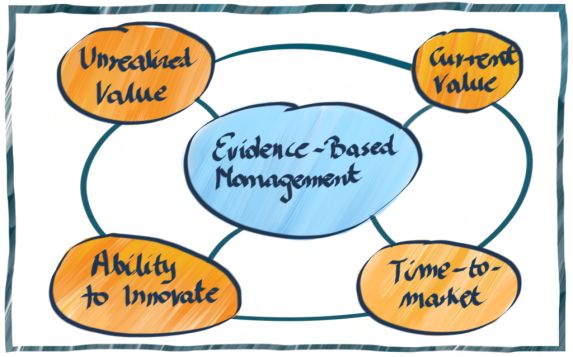I was inspired to write this article by you, my dear customers and students! Many of you were asking me about Evidence-Based Management; for some of you, I serve as a consultant to help you implement the framework in your organizations.
Let’s start from the beginning, thus a definition.
What is Evidence-Based Management?
This an empirical framework to explicitly use the current, best evidence in management and decision-making.
Evidence-Based Management is used in several complex domains like medicine (Evidence-Based Medicine), education, software development, product development, business, marketing, research & development, and others.
Scrum.org’s Evidence-Based Management (EBM) framework is
“… an empirical approach that provides organizations with the ability to measure the value they deliver to customers and the means by which they deliver that value, and to use those measures to guide improvements in both.”
From Evidence-Based Management Guide
The purpose of the framework is to make better decisions based on facts, on what we already know, on evidence.
Organizations search for evaluating their success and focusing on investments in areas that will bring the highest possible values. The framework might help to achieve a greater product or organizational goal.
EBM consists of 4 key-value areas. Each of these areas has a specific set of measures (exemplary).

Current Value – reveals the value that the product delivers to customers, today. [1]
Time-to-Market – expresses the organization’s ability to quickly deliver new capabilities, services, or products.[2]
Ability to Innovate – Expresses the ability of a product development organization to deliver new capabilities that might better meet customer needs.[3]
Unrealized Value – Suggests the potential future value that could be realized if the organization could perfectly meet the needs of all potential customers.[4]
Which Key-Value Area is the most important? We need to look at all four Areas. They are related to each other. We are not able to reach a high current value without the others.
The organization may also consider adding their specific measures that are not explicitly included in the EBM Guide. For instance, in some business domains measuring page views, unique users or conversions make sense, in others entirely not. By extension, the organization or product defines its relevant measures.
More advice on how to start with EBM you may find in the second part. Coming soon.
[1] Evidence-Based Management Guide, Jan 2019, Scrum.org


